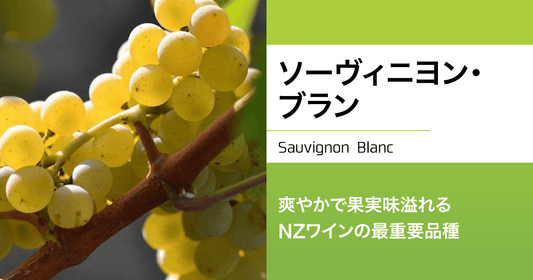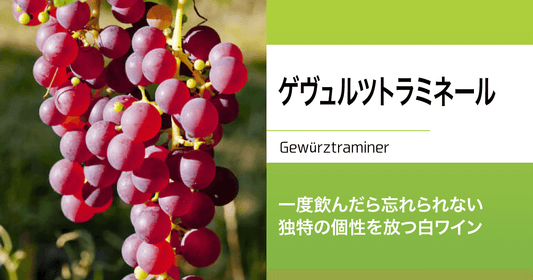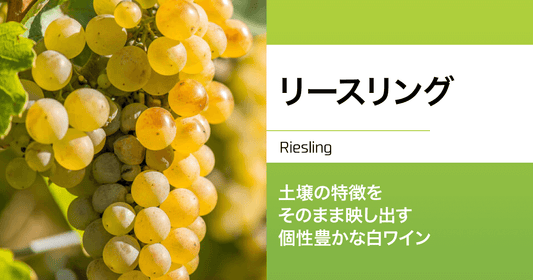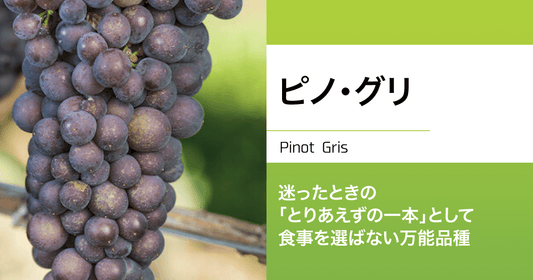
When talking about New Zealand wine, Sauvignon Blanc is an essential grape variety.
This is because it accounts for over 76% of New Zealand's total wine grape harvest and has such a presence that it can be said to be "synonymous with New Zealand wine."
Along with Chardonnay and Riesling, it is known as one of the "three major white wine grapes" and is grown all over the world, including in France, the United States, Chile, and Australia.
Its most distinctive feature is its refreshing aroma, including herbs and citrus fruits.
This is especially true for New Zealand beers, and the moment you pour it into a glass, the flavors of grapefruit and tropical fruits and herbs rise from the surface of the liquid. This refreshing aroma, combined with the sharp acidity of the taste, gives a very refreshing impression.
New Zealand is a latecomer to the wine industry and has only had a short history of wine production, having only been producing wine commercially for about 40 years. It was Sauvignon Blanc that made it famous around the world.
The Sauvignon Blanc grown in this country's favorable climate is recognized worldwide as being richer in fruitiness than that of European countries, and New Zealand has captivated wine fans around the world as a country that produces unique Sauvignon Blanc.
The most well-known wine-producing region in New Zealand is the Marlborough region of the South Island, which accounts for over 70% of New Zealand's wine production. This region is the center of the production of distinctive Sauvignon Blancs throughout New Zealand.
Learning about this grape variety that represents New Zealand's white wine will make the country's wines feel much more familiar to you.
So let's take a closer look at its appeal.
A refreshing, bursting aroma and sharp acidity
What are the characteristics of the Sauvignon Blanc grape?
In a word, it is an extremely refreshing white wine grape.
 This is Kimura Cellars Sauvignon Blanc 2018
This is Kimura Cellars Sauvignon Blanc 2018
However, the word "refreshing" may be a little difficult to understand for those who are not used to drinking wine.
So, I will explain the characteristics of the wine made from these grapes in terms of "aroma" and "taste."
Also, the impression it gives will vary greatly depending on the climate, soil, and growing method of the region in which it is grown, so we will take a look at these as well.
Aromas of citrus fruits, herbs and tropical fruits
The appeal of Sauvignon Blanc is its refreshing aroma, typically reminiscent of citrus and herbs , as well as its grassy aroma, which is also described as that of green pepper or freshly cut grass.
However, the type and strength of these scents vary greatly depending on the climate, soil, and amount of sunlight in the region where they are grown. In general, herbal scents tend to be stronger in cooler regions, while fruity scents (such as citrus fruits and passion fruit) tend to be stronger in warmer regions.
As an example, let's compare the fragrance trends of the Loire region of France with those of New Zealand.
| France (Loire) | Herbs, lime, green apple, etc. The herbal scent is particularly strong. |
| new zealand | The herbs are complemented by bursts of fruit flavors, such as passion fruit and grapefruit. The aroma of tropical fruits is particularly strong. |
In European countries, especially France, it is often grown in cooler climates, and its scent tends to be dominated by herbs. Its clean, subtle scent makes it easy to pair with food.
On the other hand, those grown in sunny, relatively warm regions such as California, Chile, and New Zealand tend to have a stronger fruity flavor than herbal flavor.
The fruity flavor is characterized by the inclusion of not only citrus fruits, but also rich fruits such as tropical fruits grown in southern countries.
The aroma changes depending on the aging period.
The aroma of Sauvignon Blanc changes during the aging period, and generally there are the following differences:
- When you're young → Cut grass
- Aged → Gentle herbs and honey
Both are excellent, but if you are going to drink New Zealand wine, try drinking it as young as possible. New Zealand Sauvignon Blanc is characterized by its refreshing and bursting fruit aroma, and is best drunk fresh.
Bursting fruitiness, sharp acidity, refreshingly dry
Following the aroma, let's look at the general taste characteristics.
| Fruity | It has a rich fruit flavor, which is more pronounced in warmer climates. |
| acidity | Sharp acidity. Gives a very refreshing impression. |
| sweetness | There are sweet dessert wines too, but most are dry. |
| Alcohol content | The majority is between 12 and 13 degrees. |
Sauvignon Blanc has a rich fruity flavor, just like its aroma. It also has a sharp acidity, and most wines are refreshingly dry.
Explore the origins and roots of words
In addition to the aroma and flavor, knowing a little about the background of the grapes can deepen your understanding of wine. Here, we will learn about the origin of the name Sauvignon Blanc and its place of origin.
Etymology
The name Sauvignon Blanc is derived from the French words sauvage , meaning "wild," and blanc , meaning "white."
It was named "wild white (grape)" because of its vigorous tree growth and powerful fragrance.
Place of Origin
Until recently, it was believed to have originated in the Bordeaux region of France.
However, recent DNA tests have shown that one of the parents is likely to be Savagnin, which is primarily grown in the Loire region, so it is believed that the grape may have originated in the Loire region.
Sauvignon Blanc's Parentage
Did you know that Sauvignon Blanc has a famous offspring grape variety?
Cabernet Sauvignon, the quintessential red wine grape, is actually a child variety of Sauvignon Blanc, resulting from a natural cross with Cabernet Franc.
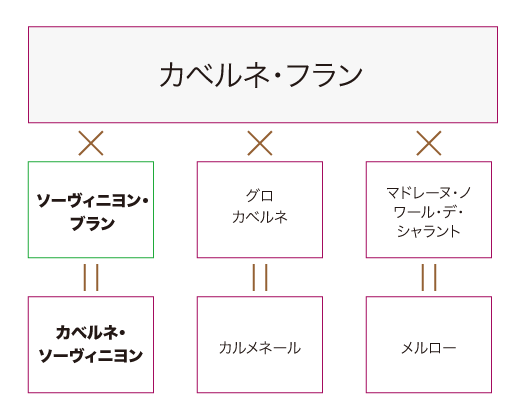
There are countless grape varieties in the world, but surprisingly, some of the most famous grapes are very closely related to each other.
Fresh and fruity New Zealand Sauvignon Blanc
Sauvignon Blanc is New Zealand's national grape variety. Its aroma and flavor are truly "fresh and fruity." Its quality is also high, and its presence in the world is growing year by year.
Taking advantage of its late start in the wine industry, South Korea has been able to efficiently incorporate the technology and know-how that has been accumulated in the wine world, and as a result has been able to release wines of astonishingly high quality one after another.
The production breakdown by grape variety in New Zealand in 2022 is as shown in the table below, with more than 70% of the wine produced domestically being Sauvignon Blanc.
| 1st place | Sauvignon Blanc | 76.5% |
| 2nd place | Pinot Noir | 6.7% |
| 3rd place | Pinot Gris | 5.9% |
Source: 2022 Vintage Data
New Zealand Sauvignon Blanc is delicious right from the first sip. It has a very fruity taste, like grapefruit. After swallowing the wine, the intense aroma, which can be called a fruit bomb, hits you from your mouth to your nose.
Marlborough is the region that represents New Zealand's Sauvignon Blanc
Marlborough, located in the northeast of New Zealand's South Island, is the country's largest wine producing region. It has an overwhelming share of the domestic market, with more than 80% of wine grapes grown in Marlborough, including not only Sauvignon Blanc but all varieties.
This region is extremely suitable for growing wine grapes, with abundant sunshine and large temperature differences between day and night. Approximately 80% of the cultivated area is Sauvignon Blanc.
There are many small, family-run wineries known as boutique wineries in New Zealand, but the Marlborough region is also home to many large wineries.
This region is relatively flat, and large wineries own vast tracts of land. They are increasing production by using the latest technology, including machinery for harvesting grapes.
With the establishment of this mass production system, wines at relatively affordable prices have begun to circulate in New Zealand, a country that is said to have a limited number of cheap wines, and in recent years, New Zealand Sauvignon Blanc has become more readily available in Japanese supermarkets and convenience stores.
▶ Click here for more information about the Marlborough region
Cloudy Bay is the driving force behind this sudden rise in popularity
Compared to the traditional wine-producing countries of Europe ( the Old World ), New Zealand has a short history and is a latecomer to the world of wine. However, it was the winery Cloudy Bay, founded in 1985, that made the country famous.
The 1996 vintage Sauvignon Blanc was highly praised by a prestigious wine magazine for its fruity aroma and refreshing taste that fills the mouth.
Its reputation quickly spread around the world, and the status of New Zealand wine rose dramatically.
▶ Learn more about Cloudy Bay here
How to choose and enjoy
Now let's explain how to actually buy and drink Sauvignon Blanc.
We'll introduce you to our recommendations, including what to look out for when buying and what meals they go well with!
How to buy | Buy wines that cost more than 2,000 yen at first
The price of wine varies widely, with some costing over 4,000 yen at supermarkets and others costing as little as 500 yen. Beginners tend to buy the cheaper wines, thinking that they are just for beginners.
However, our recommendation is that "for your first wine, try one that costs over 2,000 yen."
Of course, there are delicious wines in the 1,000 yen range. However, the probability of finding one drops dramatically. If you spend 2,000 yen, you will have a much higher chance of finding a delicious wine.
In particular, avoid Sauvignon Blanc sold at convenience stores. Even if you have already bought it, try buying one in the 2,000 yen range at a supermarket or online. I'm sure you will notice the difference.
New Zealand Sauvignon Blanc in the 2,000 yen range is quite high quality, with a rich fruity aroma.
How to enjoy | Recommended food pairings
Wine can be enjoyed even more if you consider how it will pair with your food.
In Japan, there is not much of a tradition of enjoying wine on a daily basis, but thinking about "What wine should I pair with tonight's meal?" can add more enjoyment to your life.
So, what kind of food goes well with Sauvignon Blanc, the main feature of this page?
NZ Sauvignon Blanc is refreshing and fruity, and we recommend pairing it with the following dishes that complement each other.
salad

We recommend a citrus dressing to match the citrus notes of the wine.
Dishes using herbs and lemons
Basil pasta and grilled chicken with herbs, etc.

White Fish Meuniere

Chicken Saute

In addition to just matching wine with food, it's also fun and recommended to plan a menu around wine!
Situation | Great for the dinner table, or even under the sun
Sauvignon Blanc is best enjoyed at the dinner table, of course, but it's also best enjoyed in a sunny situation, such as on a picnic or on the grass.
We also highly recommend chilling the bottle in ice water and enjoying it with light snacks such as sandwiches and canapes.
It will also spark conversations with family and friends!

The world's leading Sauvignon Blanc growing countries
Sauvignon Blanc is grown not only in New Zealand but all over the world.
Typical producing areas include France (Bordeaux, Loire, and Southwest), Spain, the United States (California), Chile, South Africa, and Australia.
In addition, although production volumes are small, Japan also produces high-quality Sauvignon Blanc.
Let's take a look at the characteristics of each country and region.
France
The Bordeaux and Loire regions of France are the birthplace of Sauvignon Blanc and are the most famous wine-producing regions in the world.
Both regions are in the west of France (on the Pacific coast), with Bordeaux further south than the Loire region.
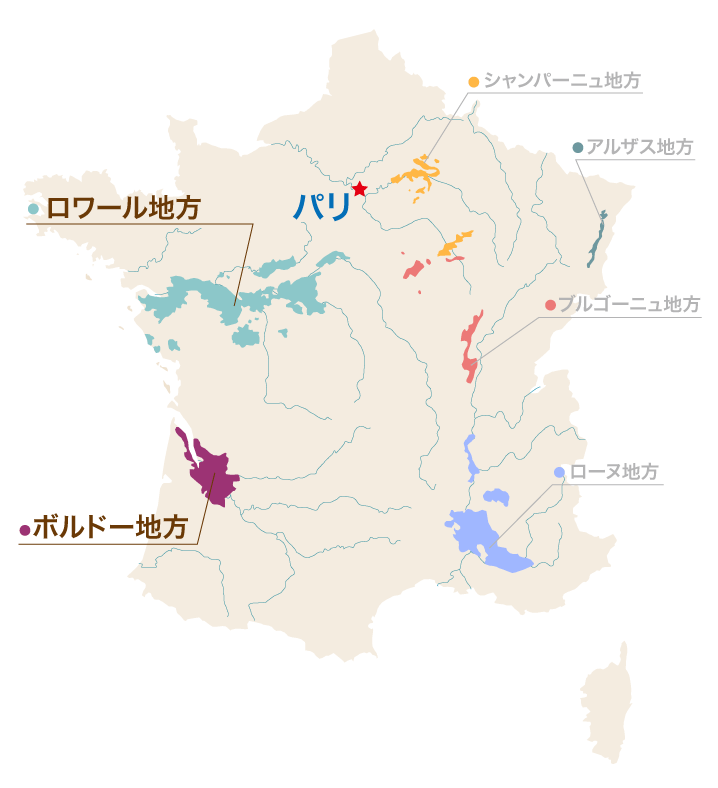
The characteristics of Sauvignon Blanc grown in these regions are as follows:
| Bordeaux Region | It is blended with Semillon , which is said to be a good match. Many producers age it in wooden barrels. It has a complex, mellow aroma and flavor. |
| Loire | Sancerre and Pouilly-Fumé are famous upstream of the Loire River. Made from a single variety (100% Sauvignon Blanc), it has a refreshing, gentle, clean taste. |
Bordeaux Region
The Bordeaux region is famous for its red wine called Bordeaux Blend . It produces an overwhelming amount of wine, with about 90% of the wine produced in Bordeaux being red and rosé wine .
However, even though it accounts for less than 10% of the total production, the white wine produced here is also of high quality and not to be missed.
Bordeaux white wine, commonly known as "Bordeaux Blanc," is made by blending Sauvignon Blanc with Semillon, which goes well with it.
Semillon, a white wine grape variety, has a honey-like sweetness and when blended, the flavor becomes deeper.
Since the chateau , famous for its red wine, also produces white wine, you can enjoy the experience from the perspective of what the white wine produced by that chateau is like.
Those aged in barrels in particular have a complex flavor that is typical of Bordeaux wines, resulting in a rich finish.
Like Bordeaux, NZ also has wines made in wooden barrels.
In New Zealand, Sauvignon Blanc is generally made as a single varietal wine and is rarely mixed with Semillon, but there are a few Bordeaux-style wines that are aged in wooden barrels.
Sileni, which is imported into Japan in large quantities, also sells barrel-aged products, so if you're interested, be sure to check it out.
Loire
Until the 1970s, Sauvignon Blanc was synonymous with Sancerre and Pouilly-Fumé from the Loire region.
These are small villages and their regions in the upper reaches of the Loire River, the longest river in France at about 1,000 km. The Sauvignon Blanc produced in this region is named after the region itself, "Sancer" and "Pouilly-Fimé", rather than the name of the variety.
It has a dry, crisp, sharp acidity and a flint-like aroma.
USA (California)
In the past, Sauvignon Blanc was dominated by France, but it was Robert Mondavi , known as the father of California wine, who dramatically changed that trend.
In 1971, a single varietal Sauvignon Blanc wine was released under the name "Fumé Blanc" and quickly spread around the world, with other countries beginning to plant it as well.
This sparked a boom in making Sauvignon Blanc from a single variety, whereas up until then it had mainly been a blend.
At Robert Mondavi
- Fumé Blanc is Sauvignon Blanc aged in barrels.
- Sauvignon Blanc is one that is not aged in barrels.
By calling them differently, we make the difference easier to understand.
▶ Robert Mondavi Winery Official Website
However, because the name has become widely used in the United States, the name "Fumé Blanc" is sometimes used instead of Sauvignon Blanc for California wines other than those made by Robert Mondavi.
Japan
In Japan, the most famous white wine grape varieties are Koshu and Niagara.
Sauvignon Blanc still accounts for less than 1% of the total production, but it has become increasingly popular in recent years and is grown mainly in cooler regions such as Nagano, Hokkaido, Aomori and Yamagata.
Japanese Sauvignon Blanc is characterized by its clarity, strong green tones, strong acidity and crisp taste, and gentle aromas of herbs and citrus fruits.
Here we will introduce some Japanese Sauvignon Blanc.
Suntory | Tsugaru Sauvignon Blanc (Aomori Prefecture)
Suntory's Japan Premium series is wine made from 100% domestic grapes.
Tsugaru Sauvignon Blanc is grown in fields overlooking Mount Iwaki in Hirosaki City and brewed at the Tomioka Winery.
It has a rich aroma of green grass and passion fruit.
▶ Tsugaru Sauvignon Blanc (Suntory)
Asahimachi Wine (Yamagata Prefecture)
Asahi Town, located in the center of Yamagata Prefecture, is a region famous for its apples and wine.
Asahimachi Wine's Sauvignon Blanc is characterized by its gorgeous citrus aroma and refreshing acidity.
Chateau Mercian, Waniko Sauvignon Blanc (Nagano Prefecture)
Sauvignon Blanc grown in Mariko's fields in Ueda City, Nagano Prefecture.
In addition to citrus fruits such as grapefruit and lime, it has a refreshing scent of tropical fruits and herbs.
▶ Wanko Sauvignon Blanc (Chateau Mercian)
Chile
Chilean grapes, grown in plenty of sunlight, are high quality, reasonably priced, and offer excellent value for money.
The most widely grown white wine grape in Chile is Sauvignon Blanc (with Chardonnay coming in a close second).
Chile stretches from north to south, and its aromas and flavors are diverse. Some have the scent of tropical fruits like passion fruit, while others have the scent of vegetables or grapefruit. There are also some that have an aroma and flavor similar to New Zealand Sauvignon Blanc.
South Africa
South Africa has a long history of wine dating back over 360 years, and produces cheap, high-quality wine.
In South Africa, the theme is making wine that is considerate of people and the environment, and they are actively working on reducing the use of pesticides and antioxidants, and producing fair trade wines.
Chenin Blanc and Colombard are representative white wine grapes, but the elegant Sauvignon Blanc, which takes advantage of the cool climate and has a good balance of acidity and fruitiness, is also attracting attention around the world.
Australia
Australian Sauvignon Blanc is produced both as a single grape and as a blend, the latter of which follows Bordeaux's lead and uses Semillon.
It is grown in the cooler regions of Australia's vast land area.
It has a distinctive aroma reminiscent of white peach and lime.
summary
Sauvignon Blanc is the variety that brought New Zealand wine to the world's attention. Its presence is huge and it has had an immeasurable impact all over the world.
The amazingly refreshing aroma and rich fruitiness are truly "fresh and fruity." Its distinct personality captivates people.
This is a white wine that I would especially recommend to those who are just starting to drink wine.
Please enjoy New Zealand Sauvignon Blanc by trying different varieties and comparing them.



